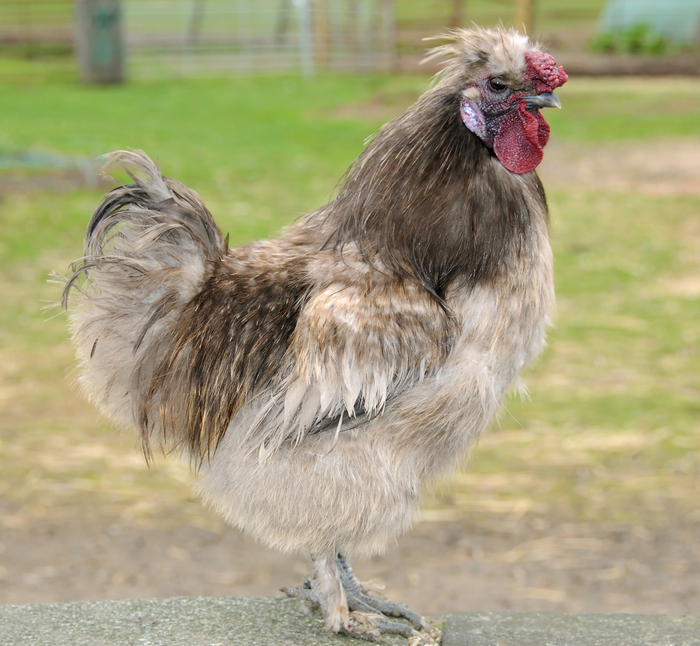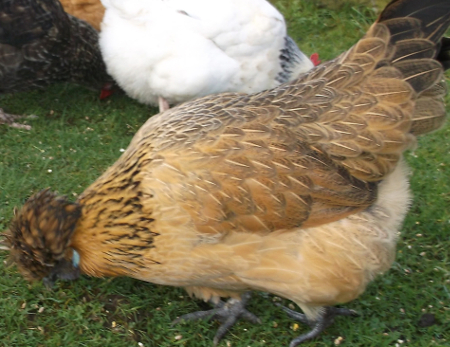The Silkie cockerel

Are Silkie cockerels good in the backyard flock?
Silkie roosters are more docile and better natured than some other breeds. The boys make good pets and will look after their ladies well. They are happy go lucky additions to the backyard flock.
Below: A Silkie rooster.

The general characteristics of the male Silkie:
Carriage: Stylish, compact and lively.
Type: Body broad and stout looking.
Back: Short, saddle silky and rising to the tail.
Stern: Broad and abundantly covered with fine fluff, saddle hackles soft, abundant and flowing.
Breast: Broad and full, shoulders stout, square, and fairly covered with neck hackle.
Wings: Soft and fluffy at the shoulders, with the ends of the flights ragged and ‘Osprey plumage; (i.e. some strands of the flights hang loosely downwards).
Tail: Short and very ragged at the end of the harder feathers of the tail proper. It should not be flowing, but forming a short round curve.
Head: Short and neat, with good crest, soft and full, and as upright as the comb will permit, and having a six to twelve soft silky feathers streaming gracefully backwards from the lower back part of the crest to a length of 3.75 cm (1½ ins).
The crest: Should not show any hardness of feather.
Beak: Short and broad at the base.
Eyes: Brilliant black, and not too prominent.
Comb: Almost circular in shape, preferably broader than long, with a number of small prominence's over it, and having a slight indentation or furrow transversely across the middle.
Face: Smooth.
Wattles: Concave, nearly semi-circular, and not long or pendant. Ear lobes more oval than round.
Neck: Short or medium length, broad and full at the base, with the hackles abundant and flowing.
Legs and feet: Free from scaliness.
Thighs: Wide apart and legs short. No hard feathers on the hocks, but a profusion of soft silky plumage is permissible. Thighs covered with abundant fluff. The feathers on the legs should be moderate in quantity.
Toes: Five in number, with the fifth toe diverging from the fourth. The middle and the outer toes feathered, but these feathers should not be too hard.
Plumage: Very silky and fluffy, with a profusion of hair like feathers
Are Silkie roosters as aggressive as other breeds?
Usually not, but you can always get an exception. They may still fight with other roosters though even though they are good with people.
You can breed aggressiveness out of them to some extent over time.
Depends entirely on breeders. It’s hereditary. My nice boys are from nice daddies my mean roosters follow their dads claw steps. I only breed nice adult roosters for my lines now. Handling has no effect.
Not mine. The silky roosters we have are so much sweeter than our other roosters.
I had 6 Silkie roosters at one point & only one was a jerk.
I have many roosters of all different breeds. My only mean one is my Silkie ! He straight up attacks every time you open the door. He will charge out at your legs !
Mine have been 10 nice ones to one mean. Most have been wonderful
My rooster was hand raised and has never been mean. He is even gentle with the ladies.
Do Silkie roosters have Spurs?
All male chickens will eventually grow spurs and Silkies cockerels are no different. The eventual size of the spurs and the speed of growth will vary greatly.
Silkie roosters are larger than hens and they do have spurs. Some spurs just grow to points about an inch long and some grow into huge great curves.
What age do Silkie roosters start crowing?
All Silkie males are capable of crowing from 3 months of age, but not all will.
Silkies as young as 2 months old have been known to crow and chest bump, but I have had some that have not begun crowing until nearly a year old.
Silkie cockerels seem to prefer to keep themselves away from other males and are less likely to crow if you have other mature roosters around.
Do Silkie roosters crow loudly?
Their crow is not as loud as most other roosters. The large or standard sized fowl will have a bigger crow.
They are also bantams and all bantams don't have as much volume in the crow.
I have had both sizes of Silkies before and would compare them to Orpington chickens.
Can you eat a Silkie rooster?
In the States, Silkies are kept as novelties , or as docile roosters, or hens known for their broody qualities.
Silkie soup is traditionally a Chinese dish, with the meat being coveted for its health benefits.
Yes you certainly can eat the surplus males as you would any other chicken.
Will a Silkie cockerel be able to breed with other hens?
Yes, as long as the size difference is not too great a Silkie cockerel will have no trouble mounting and mating with a hen of another breed.
I have successfully raised Barnevelder cross Silkies as broody hens. There has always been a good percentage of viable eggs and a correspondingly good hatch rate.
Below: A Silkie cross hen.

A small bantam rooster will struggle to breed with a Rhode Island Red for instance.
How long do Silkie roosters live?
A standard male Silkie will live to between 6 and 10 years.
This does all depend on how well they are looked after and the care given to them.
Some Silkies have been known to live longer but I have never had one more than 9 years.
Keep them free range and stress free and they will have a long happy life.
